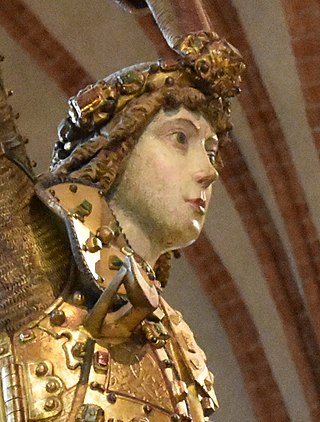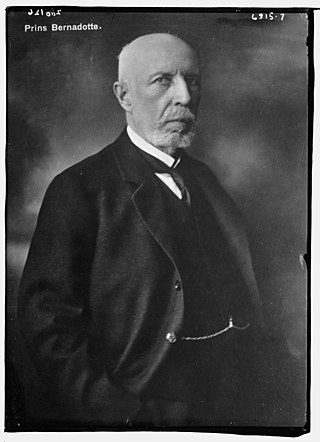
Riksdag of the Estates was the name used for the Estates of Sweden when they were assembled. Until its dissolution in 1866, the institution was the highest authority in Sweden next to the King. It was a Diet made up of the Four Estates, which historically were the lines of division in Swedish society:

Sten Sture the Elder was a Swedish statesman and regent of Sweden from 1470 to 1497 and again from 1501 to 1503. As the leader of the victorious Swedish separatist forces against the royal unionist forces during the Battle of Brunkeberg in 1471, he weakened the Kalmar Union considerably and became the effective ruler of Sweden as Lord Regent for most of his remaining life.

Albert was King of Sweden from 1364 to 1389 and Duke of Mecklenburg-Schwerin from 1384 to 1412.

The Swedish nobility has historically been a legally and/or socially privileged class in Sweden, and part of the so-called frälse. The archaic term for nobility, frälse, also included the clergy, a classification defined by tax exemptions and representation in the diet. Today the nobility does not maintain its former legal privileges although family names, titles and coats of arms are still protected. The Swedish nobility consists of both "introduced" and "unintroduced" nobility, where the latter has not been formally "introduced" at the House of Nobility (Riddarhuset). The House of Nobility still maintains a fee for male members over the age of 18 for upkeep on pertinent buildings in Stockholm.

Prince Oscar Carl August Bernadotte, Count of Wisborg was a Swedish religious activist, the second son of King Oscar II of Sweden and his consort, Sofia of Nassau. Born as a Prince of Sweden and Norway, he was known as Prince Oscar, Duke of Gotland. However, by marrying contrary to Swedish constitutional requirements, he lost those titles, becoming instead Luxembourgish nobility as Prince Bernadotte and Count of Wisborg.

Karin Månsdotter was first the mistress and then the Queen of King Eric XIV of Sweden.

The House of Nobility in Stockholm, Sweden, is a corporation and a building that maintains records and acts as an interest group on behalf of the Swedish nobility.

Carl Gustaf Pilo was a Swedish painter. Pilo worked extensively in Denmark as a painter to the Danish Royal Court and as professor and director at the Royal Danish Academy of Art, as well as in his native Sweden.

The Finnish nobility was historically a privileged class in Finland, deriving from its period as part of Sweden and the Russian Empire. Noble families and their descendants are still a part of Finnish republican society, but except for the titles themselves, no longer retain any specific or granted privileges. A majority of Finnish nobles have traditionally been Swedish-speakers using their titles mostly in Swedish. The Finnish nobility today has some 6,000 male and female members.

The Jägerhorn af Spurila family is a noble family, registered with number 114 in the Swedish House of Nobility and number 5 in the Finnish House of Nobility. Members of this family live in Finland, Sweden, France and the United States.

Johan Hadorph was a Swedish director-general of the Central Board of National Antiquities.

The Schantz family is a noble family of German origin in the Swedish and Finnish Houses of Nobility. They are listed as Family Number 1255 by the Swedish House of Nobility, and as Number 95 by the Finnish House of Nobility. The family was knighted in Sweden in 1693 and was immatriculated in to the Finnish nobility in 1818.

Peter Estenberg lived in the late 17th - early 18th century and was a member of the Swedish nobility of the house of Estenberg, a noted scholar, and an ambassador to Poland. His family coat of arms is displayed in the Riddarhuset in Stockholm. In the early 18th century, Peter Estenberg became an advisor to Poland's King Stanislaw. Peter Estenberg was also a master of Greek language, a tutor to the Swedish royal family, and a professor of Greek studies and Philosophy at the University of Lund, and later the rector of Jamshog and Nasum's parishes.
Benzelius is the surname of a Swedish family of pastors and theologians, which originated in Bensbyn in the municipality of Luleå, from which the surname was formed in Latin.
Edenberg was once the surname of a Swedish noble family formerly known as Eden. Today, it is a surname used also by Swedish commoners.

The Hammarskjöld family, also known as Hammarskiöld family, is a Swedish noble family, enrolled in Riddarhuset with the number of 135.

Prince Oscar of Sweden, Duke of Skåne is the younger child and only son of Crown Princess Victoria and her husband, Prince Daniel. He is a grandson of King Carl XVI Gustaf and Queen Silvia and is third in the line of succession to the Swedish throne, after his mother and his sister, Princess Estelle.

The Wachtmeister family is a Swedish noble family from Livonia, who immigrated to Sweden in the 16th century. The name Wachtmeister is German for 'sergeant'.

Löfvenskiöld was a Swedish noble family, one branch of which was elevated to the rank of Baron. The noble family has been extinct on the patrilineal side since 1892. The family is also known as Löwenskiöld and also as Löfvingsson.
The Assembly of Nobles is the principal decision-making body of the House of Nobility. It convenes every three years at the Palace of the Nobility in Stockholm to make decisions regarding the management of the properties and foundations under the ownership of the House of Nobility, the affairs of the nobility and the budget of the House.
















